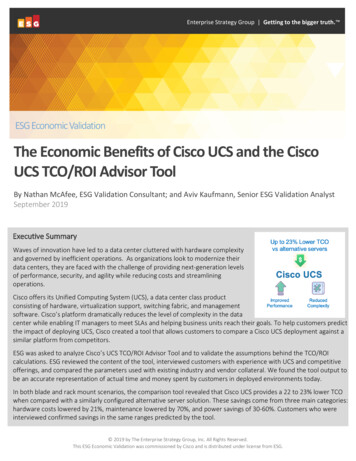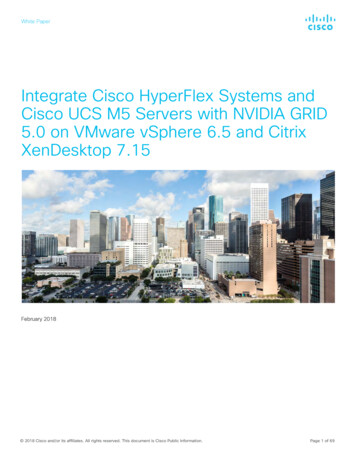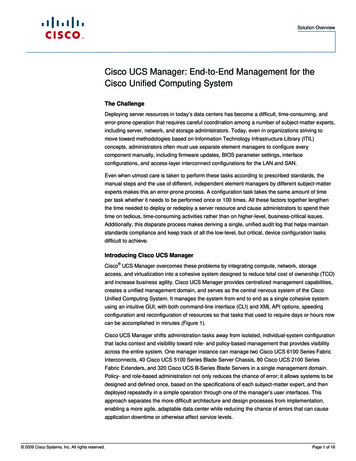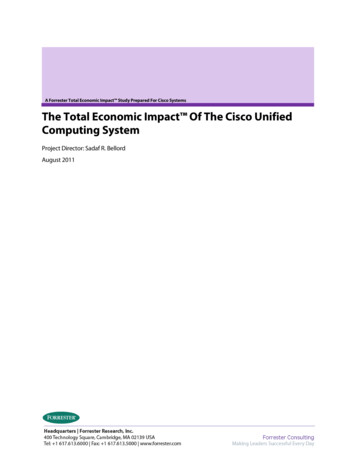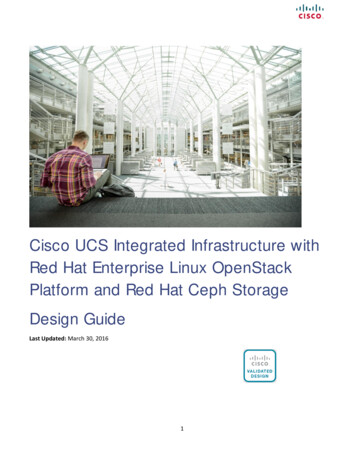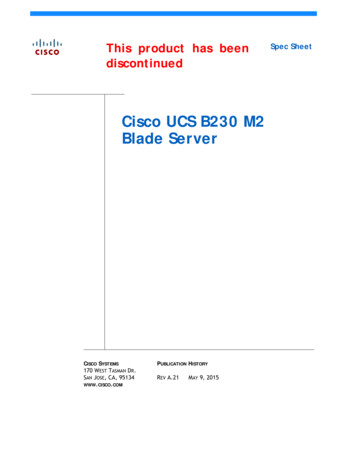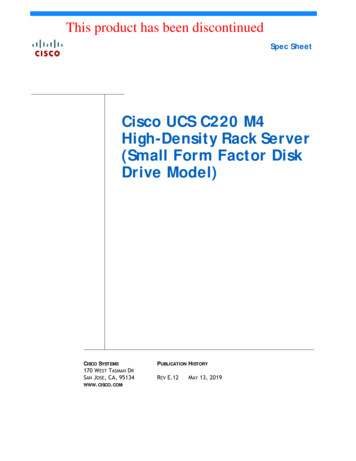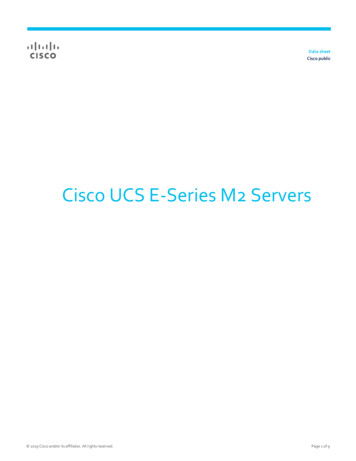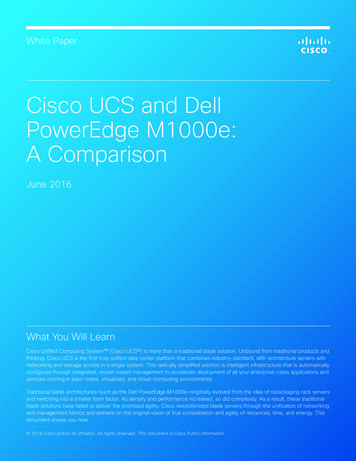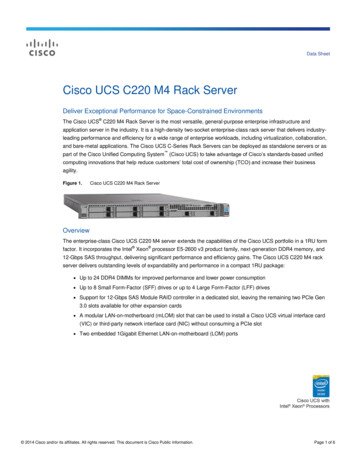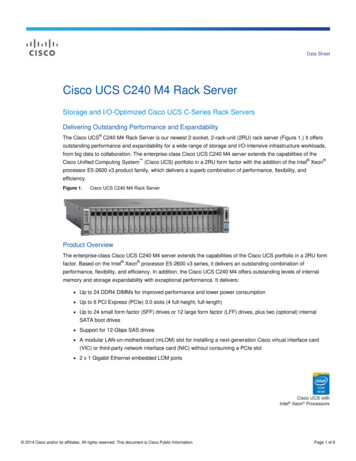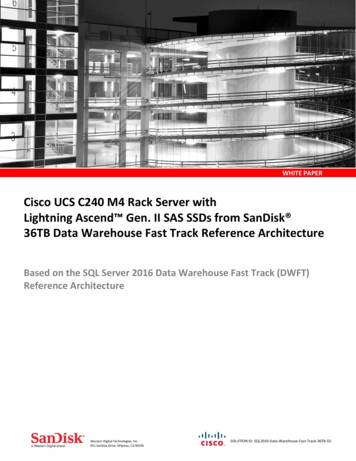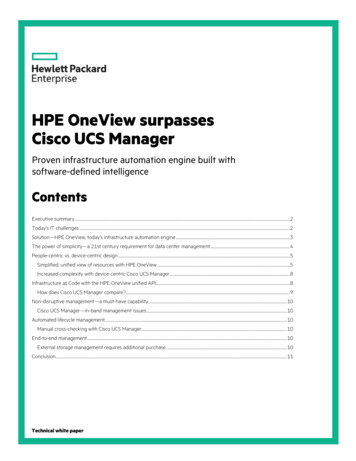
Transcription
HPE OneView surpassesCisco UCS ManagerProven infrastructure automation engine built withsoftware-defined intelligenceContentsExecutive summary.2Today’s IT challenges .2Solution—HPE OneView, today’s infrastructure automation engine .3The power of simplicity—a 21st century requirement for data center management .4People-centric vs. device-centric design .5Simplified, unified view of resources with HPE OneView.5Increased complexity with device-centric Cisco UCS Manager .8Infrastructure as Code with the HPE OneView unified API.8How does Cisco UCS Manager compare?.9Non-disruptive management—a must-have capability. 10Cisco UCS Manager—in-band management issues . 10Automated lifecycle management. 10Manual cross-checking with Cisco UCS Manager. 10End-to-end management . 10External storage management requires additional purchase. 10Conclusion . 11Technical white paper
Technical white paperPage 2Executive summaryWe live in a disruptive age. Entire industries are in a state of flux, with businesses struggling to innovate, cut costs, and improve efficiency—all atthe same time. Companies must either open new markets or disrupt existing ones to stay ahead of established competitors and fend off newmarket entrants.Success in this environment requires you to turn ideas into value faster than the competition. To stay ahead of the competition, the businessrelies on IT to move quickly, but IT is often mired in “operations quicksand,” forced to use complex manual processes that delay projects forweeks or months. Archaic management tools and processes fail to provide the speed and simplicity that IT needs to support line-of-businessrequirements.To overcome these challenges, IT leaders must redefine technology models. They need breakthrough management that increases speed andsimplicity, which their business counterparts require.This document compares and contrasts two management solutions—HPE OneView and Cisco UCS Manager. 1 The document illustrates whyHPE OneView is the solution of choice for boosting speed, productivity, and efficiency, through innovation and customer focus.Today’s IT challengesIn addition to managing shrinking budgets and meeting growing demands from internal stakeholders, IT faces a long and diverse list of challenges.Table 1. Today’s IT challengesChallengeDescriptionSiloed infrastructureDedicating resources to individual workloads to ensure SLAsLack of management standardizationResulting in a complex array of tools being used to deploy, manage, and report on the end-to-end infrastructureUsing scripts that are complex and difficult to maintainCreating more work for an already over-burdened IT staffIntegrating management toolsetsEnsuring all toolsets work as expectedConstant pressure to deliver infrastructure fasterEnabling the business to respond to changes and new requirementsRelentless pressure to do more with lessIn an effort to become a leaner organizationDemand from users to deliver mobile and cloud appsRequiring faster application developmentStandardizing operations and infrastructureIn an effort to drive down costs, increase customer satisfaction, and improve competitivenessReducing costBy boosting efficiencyTrying to focus less on maintenance and more oninnovatingHelping to increase competitive advantageManaging compliance issuesRemaining up to date on, and compliant with, the latest rules and regulations1Using a combination of publicly available information found on cisco.com and HPE internal analysis
Technical white paperPage 3Solution—HPE OneView, today’s infrastructure automation engineDesigned to simplify operations and increase the speed of IT delivery for new applications and services, HPE OneView is your infrastructureautomation engine. Using software-defined intelligence, HPE OneView brings a new level of automation to infrastructure management by takinga template-driven approach to provisioning, updating, and integrating compute, storage, and networking infrastructure. Designed with a modern,standards-based API and supported by a large and growing partner ecosystem, HPE OneView also makes it easy to integrate powerfulinfrastructure automation into existing IT tools and processes.While competitive solutions such as Cisco UCS Manager claim to simplify the management landscape, HPE OneView actually accomplishes theobjective. By offering one of the industry’s best infrastructure management experiences, HPE OneView enables you to: Simplify operations—Agentless monitoring, online firmware updates, and a new Global Dashboard deliver streamlined lifecycle operations atscale. Deploy infrastructure faster—Template-based automation enables IT generalists to provision resources rapidly and reliably in response toapplication owner requirements. Increase productivity—A unified API gives developers and independent software vendors (ISVs) the power to unify infrastructureautomation with application and IT service delivery.Based on its significance to Hewlett Packard Enterprise’s software-defined data center (SDDC) and Composable Infrastructure strategies—wherea powerful new architecture drives innovation and value creation for today’s new breed of applications, while also running traditional workloadsmore efficiently—HPE OneView is strategic to the future of Hewlett Packard Enterprise, so you can build on it with confidence. HPE OneView is akey enabling technology that can easily integrate into your existing environments, in addition to providing a management platform for the cloudand the SDDC.Table 2. HPE OneView resolves today’s IT challengesChallengeDescriptionHPE OneView solutionSiloed infrastructureDedicating resources to individual workloads to ensure SLAsSingle converged management tool for servers, storage, and networkingManagement tool complexityToo many handoffs between a complex array of tools used todeploy, manage, and report on the infrastructureBringing multiple management tools (HPE Insight Control, Virtual ConnectManager, Virtual Connect Enterprise Manager, and Smart Update Manager)under a single experienceToo much time troubleshootingand remediating problemsLack of standardization in infrastructure configurationsServer Profile Templates establish known good configurations that can bedeployed consistently, reducing configuration variability and human errorComplexity of infrastructureautomationScripting for multiple management tools is complex anddifficult to maintain, creating more work for an alreadyover-burdened IT staffUnified RESTful API for configuring servers, storage, and networkingsimplifies infrastructure automation, enabling an entire infrastructure to bespecified with a single line of codeIntegrating management toolsetsEnsuring all toolsets work as expected, both alone and inconcert with other toolsetsExtensive DevOps partner integrations leverage the unified API inHPE OneViewConstant pressure to deliverinfrastructure fasterEnabling the business to respond to changes and newrequirements as they emergeInfrastructure policies (Server Profiles, Fabrics, Storage) allow ITadministrators to provision infrastructure together, instead of performinglengthy hand-off proceduresRelentless pressure to do morewith lessIn an effort to become a leaner organizationUnified management console enables a larger IT-staff-to-infrastructureresources ratio; you can manage more infrastructure with fewer IT resources,using the HPE OneView unified management console to gain better visibilityof servers, storage, and networkingReducing costBy boosting efficiencyAutomated processes streamline day-to-day tasks; templates ensure greateraccuracy and speed resource provisioningTrying to focus less onmaintenanceHelping increase competitive advantageAutomation enables admins to focus more on innovation andrevenue-generating activitiesManaging compliance issuesRemaining up to date on the latest rules and regulations;ensuring IT systems align with compliance mandatesParent policies enforce the best practice and allow admins to track andremediate non-compliant resources
Technical white paperPage 4The power of simplicity—a 21st century requirement for data center managementIn a world where time is the new currency, simplicity is a must-have characteristic for every IT solution. The proliferation of software-definedtechnology, an influx of tech-savvy workers, and an increase in business complexity are widening the gap between business demand andtraditional IT supply. Organizations are now struggling to deliver and manage IT using outdated management tools that were designed for apast era. HPE OneView improves the productivity of IT administrators with an intuitive user interface and automated intelligence that simplifiescommon tasks. The most common data center processes—such as deployment, updating, migrating, and troubleshooting—are reduced fromhours or days to minutes. 2To develop HPE OneView, HPE collaborated with more than 150 leading customers across 30 real-world data centers worldwide, for morethan four years, to understand the drivers of cost, inefficiencies, and delays around the most common infrastructure management tasks,processes, and steps. HPE also examined everyday modern consumer applications that are purpose-built to perform specific tasks withsimplicity and speed, and then applied those lessons to the complexity and scale of the data center. These efforts led to a platform thattranslates complex management work into the clear language of everyday human interactions. 3That’s HPE OneView—a solution designed for the way the modern world works. 4HPE OneView delivers the simplicity and intuitive user experience most customers require. The HPE OneView user interface (UI) is not only easyto use, but also enables users to navigate to the information they need, access it, and trust that the information is accurate—all quickly andefficiently. Best of all, it is very intuitive, so ramp-up requires less time.For day-to-day administrative tasks, HPE OneView simplifies how you design resource components, ranging from connectivity to fabrics, fromnetworking to storage, and from embedded storage to end points. Previous versions of HPE OneView took important strides to reduceadministrative overhead, and we continue to forge ahead with the latest release of the product. Today, we enable users to manage multipleresources at the same time by applying master policies for a given workload in the form of Server Profile Templates, Logical Interconnect Groups,Enclosure Groups, and Storage Volume Templates.The HPE OneView Global Dashboard takes composable infrastructure management to new levels of simplicity and efficiency. The Dashboardbuilds on the core HPE OneView capabilities by adding visibility and reporting across multiple appliances in different geographic regions. Withthe HPE OneView Global Dashboard, your business benefits from: The ability to troubleshoot alerts and view core inventory data across as many as ten HPE OneView appliances Smart Search of all IT assets Single sign-on, in-context launch for all managed resources, even across data centers234HPE OneView is up to 9X faster for problem resolution than Cisco UCS Manager. Based on testing commissioned by HPE and performed by Demartek comparing the time toidentify and resolve an error with server downlinks. Demartek results: HPE OneView: 0 minutes—59 seconds, 10 steps; Cisco UCSM: 9 minutes—13 seconds, 28 steps. Demartektest report, “HPE OneView Evaluation” dated July 2014—Use Case #3.www8.hp.com/us/en/hp-news/press-release.html?id 1491630#.V QkO ame 4AA6-5521ENW.
Technical white paperPage 5Figure 1. HPE OneView Global DashboardPeople-centric vs. device-centric designThe HPE OneView user interface works the way you expect a consumer device to work, starting with a consumer-inspired user interface (UI) thatis highly intuitive and easy to use. With the consumer-inspired UI, there is a very short learning curve, so HPE OneView admins can be productivealmost immediately.Cisco UCS Manager follows what can be defined as a legacy approach to infrastructure management with a hierarchical “tree and branch,”which dramatically increases the learning curve. This leans toward a device-centric approach, rather than the people-centric design found inHPE OneView. See how HPE OneView compares in the following areas.Simplified, unified view of resources with HPE OneViewHPE OneView’s built-in Smart Search capability enables you to easily find any component in your environment. Smart Search finds devices with a200 ms response, and this response rate is unaffected by scale. Simply select resources from the List view, or use the Map View to navigate to aspecific resource. HPE OneView Map View helps to identify complex interrelationships of devices, services, and users in a single view and isdelivered in seconds.
Technical white paperPage 6Figure 2. HPE OneView Smart SearchYou can get a similar dashboard view of other resources that impact the resource you selected. HPE OneView knows if the path for a selectedresource is being impacted by other resources. You can see the relationship between resources to see service degradation, and then act on it.You can also see the connectivity points that might impact a resource in the future.With the Activity Feed, HPE OneView notifies administrators of alerts and information in an easy-to-understand, natural language.
Technical white paperFigure 3. HPE OneView Activity FeedPage 7
Technical white paperPage 8Increased complexity with device-centric Cisco UCS ManagerIn contrast, UCS Manager’s “tree and branch” UI increases complexity with scale. Cisco seems to have admitted this in reworking the UCS CentralUI to move away from the UCS Manager approach, in April 2015. 5With no intelligent search function, Cisco UCS Manager forces users to look at each individual device until they find what they are looking for—atime-consuming process, especially at scale. Cisco added search to UCS Central, which is a separate tool from UCS Manager.Infrastructure as Code with the HPE OneView unified APICloud and the SDDC require managing infrastructure as a pool of resources that can be dynamically allocated. The infrastructure is abstractedfrom the underlying hardware components using software definition. The software-defined data center is an evolution that moves the controleven further up the stack, so the applications ultimately have control of the underlying infrastructure resources. HPE OneView enables thisInfrastructure as Code functionality via a unified API.Native in HPE OneView, this API is a single line of code that enables you to automate every operation in HPE OneView, providing fullinfrastructure programmability. With the unified API, you can automate the provisioning, configuration, and monitoring of HPE OneViewmanaged IT infrastructure.The HPE unified API is a RESTful API built with JSON objects—the standard preferred by a vast majority of web-based developers. 6 Comparedto XML, which Cisco used to build UCS Manager/Central, JSON is much more lightweight and developer-friendly. 7The advantages of the REST methodology include the ability to create web services using an accepted and prevalent interface that is used tomanage large-scale environments. This well-documented public API is very useful for developers and end users who want to create their ownapp or provide integration capabilities with other applications they use. REST API calls can be made from a variety of tools and almost anyprogramming language, including cURL (a common tool available on many Linux platforms), Microsoft Windows PowerShell, Python, Ruby,Perl, and other tools that support making calls to HTTP servers. 8ISVs and developers can programmatically control a composable infrastructure through this single open API. You can see all the partners withintegrations to HPE OneView at hpe.com/info/composablepartners.This modern API has enabled a broad HPE OneView partner ecosystem, including many emerging DevOps tools such as Chef, Docker, andAnsible. Today, these and many other partners use the HPE OneView unified API to acquire certain information. For example, the Chef driverinteracts directly with the unified API to provision physical infrastructure using Server Profile Templates. The Chef Provisioning Driver forHPE OneView is built where HPE brings “Infrastructure as Code” to bare metal through templates that unify the process for provisioningcompute, connectivity, storage and OS in a single step, similar to provisioning VM instances from the public cloud.5678“UCS Manager's user interface was designed to scale to several hundred servers. We have received a lot of customer and internal feedback that while UCS Central was easy to learnif you were already familiar with UCS Manager (and gave you a single IP address to manage servers, network, and storage for thousands of servers) it didn't work as well in largescale environments where you had to scroll through lists of thousands of systems to fin
Cisco UCS Manager follows what can be defined as a legacy approach to infrastructure management with a hierarchical “tree and branch,” which dramatically increases the learning curve. This leans toward a device-centric approach, rather than the people-centric design found in HPE OneV
